Revision Notes on Animal Kingdom
Levels of structural organization of a multicellular animal
(1) Chemical Level. it is the lowest level of organization. Atoms join together to form molecules.
(2) Cellular level. The chemicals are put together to form the cellular level. cells are the basic structural and functional units of an organism (living thing), cells are of various types, specialized for different function or functions. It is called ‘division of labour’ among the cells.
(3) Tissue level. The cells that are similar in structure, origin and function form a tissue. There are four main types of tissues: epithelial, connective, muscular and nervous.
(4) Organ level. it is appropriate to consider an organs as the combination of tissues into a unit for the performance of a specific function or a series functions.
(5) System level. Several organs constitute an organ-system.

Characters of Non Chordata (Invertebrates)
The animals which lack a notochord are called invertebrates. e.g. Amoeba, sponges, Hydra, worms, insects, etc., Invertebrates are characterised by the following salient features –
(1) The vertebral column is absent.
(2) the nerve cord is solid in nature.
(3) The nerve cord is present on the ventral side and never on the dorsal side.
(4) When alimentary canal is present, it lies dorsal to the nerve cord.
(5) Invertebrates may be acoelomate or pseudocoelomate or true coelomate.
(6) They have either asymmetry or radial symmetry or bilateral symmetry.
(7) The circulatory system is open type or closed type.
(8) They exhibit all possible type of reproduction.
Characters of Chordata (Vertebrates)
The animals which possess a notochord are called vertebrates.
(1) Aquatic, aerial or terrestrial.
(2) Body small to large, bilaterally symmetrical and metamerically segmented.
(3) A post anal tail usually projects beyond the anus at some stage and may or may not persist in the adult.
(4) Exoskeleton often present; well developed in most vertebrates.
(5) Body wall triploblastic with 3 germinal layers : ectoderm, mesoderm and endoderm.
(6) Coelomate animals having a true coelom, enterocoelic or schizocoelic in origin.
(7) A skeletal rod, the notochord, present at some stage in life cycle.
(8) A cartilaginous or bony, living and jointed endoskeleton present in the majority of members (vertebrates).
(9) Pharyngeal gill slits present at some stage; may or may not be functional.
(10) Digestive system complete with digestive glands.
(11) Blood vascular system closed.
(12) Excretory system comprising proto-or meso- or meta-nephric kidneys.
(13) Nerve cord dorsal and tubular. Anterior end usually enlarged to form brain.
(14) Sexes separate with rare exceptions.
Phylum Protozoa
The name “Protozoa” was coined by Goldfuss (1817). The branch of their study is called Protozoology.
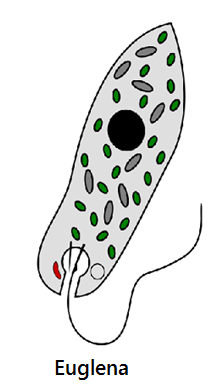 Salient Features
Salient Features
(1) Protozoans are the simple and primitive organisms
(2) free living or parasitic
(3) All the free living forms are aquatic
(4) asymmetrical or radially symmetrical or bilaterally symmetrical
(5) They are unicellular (acellular)
(6) They have protoplasmic grade of organization.
(7) Locomotion is affected by flagella, cilia or pseudopodia.
(8) Nutrition is holophytic, holozoic, saprozoic or parasitic.
(9) Digestion is intracellular
(10) Excretion & Respiration occurs by diffusion
(11) In fresh water protozoans osmoregulation is carried out by the contractile vacuoles.
(12) Encystment is a common phenomenon
(13) Reproduction occurs by asexual and sexual methods.
Classification of Protozoa
Class 1. Flagellata or Mastigophora
(1) The body is covered by a thin pellicle or cuticle.
(2) The locomotory organs are flagella.
(3) The contractile vacuoles are present in fresh water forms with accessory vacuoles.
(4) Chloroplast is found in some forms.
(5) They may be free-living or parasitic.
(6) The class flagellata has been divided into eight orders.
(7) Examples: Chrysamoeba, Cryptomonas, Euglena, Volvox, etc.
(8) Euglena is a connecting link between Animal & Plant.
(9) Trychonymph (symbiotic) live in alimentary canal of termite that is digest to cellulose.
Class 2. Rhizopoda
(1) There is no definite cell wall or pellicle
(2) There is no definite shape
(3) The locomotory organs are pseudopodia
(4) There is no permanent mouth or anus.
(5) The contractile vacuoles are present in the fresh water forms.
Class 3. Ciliophora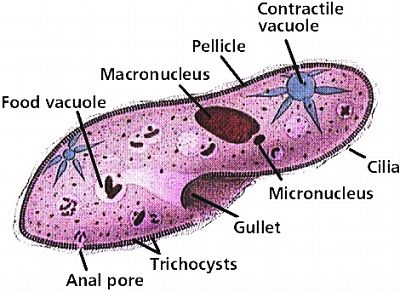
(1) The body is covered by thin pellicle
(2) They have a fixed permanent shape
(3) The locomotory organs are cilia
(4) Tentacles are present
(5) The class ciliophora is divided into two sub-classes, namely Ciliata and Suctoria.
Sub-class 1 - Ciliata
(1) Cilia are present throughout life.
(2) Tentacles are absent
(3) Mouth and cytopharynx are usually present.
(4) Contractile vacuoles are present.
(5) Trichocysts, organs of offense and defense are present in certain forms.
(6) Examples: Paramecium, Stylonchia Vorticella, etc., Paramecium is filter feeder
(7) In a paramecium two contractile vacuoles are present. Posterior contractile vacuole is highly active.
Sub-class 2 - Suctoria
(1) Cilia are present only in the young conditions and adults are devoid of them.
(2) Tentacles are present in the adult
(3) One to many contractile vacuoles are present
(4) Examples: Acineta, Dendrocometes, Dendrosoma, etc.
Class 4 - Sporozoa
(1) They are exclusively endoparasitic
(2) The body is covered by pellicle.
(3) Reproduction takes place by spore formation
(4) The class is divided into two sub-classes, namely, Telosporidia and Neosporidia
Sub-class 1 - Telosporidia
(1) The spores do not contain polar capsules or filaments
(2) The life history ends with the formation of spores.
(3) The spore cases are simple and contain many spores
(4) Examples: Monocystis, Gregarina, Isopora, Eimeria, Plasmodium, Babesia, etc.
Sub class 2 - Neosporidia
(1) The trophozoite is amoeboid multinucleated
(2) Spore cases are complex usually having a single germ
(3) Examples: Nosema, Myxidium, Globidium, etc.
Phylum Porifera
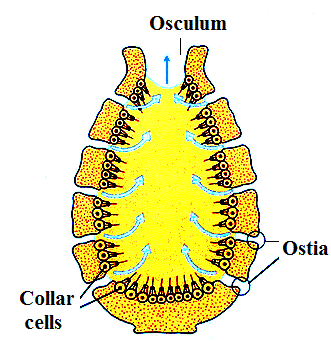 (i) The word “Porifera” means pore bearers (Gr., porus = pore; ferre = to bear); their body wall has numerous minute pores, called ostia, through which a continuous current of outside water is drawn into the body.
(i) The word “Porifera” means pore bearers (Gr., porus = pore; ferre = to bear); their body wall has numerous minute pores, called ostia, through which a continuous current of outside water is drawn into the body.
(ii) Phylum porifera has the following salient features:
(1) All the sponges are Aquatic, Sedentary, Asymmetrical or Radially,
(2) They are diploblastic.
(3) The body is perforated by numerous minute pores called ostia.
(4) The ostia open into a large cavity called spongocoel.
(5) The spongocoel opens to the outside by a large opening called osculum.
(6) The sponges possess an endoskeleton in the form of calcareous spicules.
(7) Excretion and respiration occur by diffusion.
(8) They have greater power of regeneration.
(9) Reproduction takes place by asexual or sexual methods.
(10) Development is indirect or direct. The common larval are parenchymula, amphiblastula, etc.
Class 1. Calcarea
(1) Skeleton is formed of Calcareous spicules.
(2) Radially symmetrical.
(3) Choanocyte cells are large and conspicuous. Examples: Clathrina, Leucosolenia, Sycon, etc.
(4) Euplectela is the sponge which is given as a Gift in Japan.
(5) Leucosolenia is a smallest sponge.
(6) Ectorderm is formed by pinachocyte and endoderm is formed by choanocyte.
Class 2. Hexactinellida 
(1) Skeleton is formed of six rayed triaxon, silicious spicules.
(2) Canal system is branched or unbranched.
(3) Radially symmetrical.
(4) These are also known as glass sponges.
(5) Examples: Pheronema, Hyalonema, etc.,
(6) Hylonema is a Glass rope sponge.
Class 3. Demospongia
(1) Skeleton either absent or present.
(2) The silicious spicules when present are never six rayed
(3) The canal system is complicated Rhagon type
(4) These sponges are of great economic importance
(5) Examples: Cliona, Spongilla, Chalina, Euspongia, Hippospongia, Oscarella, etc.
(6) Spongilla is a fresh water sponge.
Phylum Cnidaria (or Coelenterata)
(i) ‘Tissue grade’ eumetazoans with a radial symmetry.
(ii) The term “Coelenterata” signifies the presence of a single internal cavity called coelenteron, or gastrovascular cavity, combining functions of both digestive and body cavities. The term “Cnidaria” indicates the presence of stinging cells (Gr., knide = nittle or stinging cells).
(iii) Phylum coelenterata has the following salient features –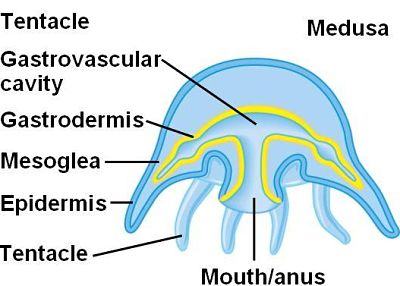
-
Coelenterates are multicellular organisms
-
They have tissue-grade of organization
-
The body is radially symmetrical. Radial symmetry is the symmetry of a wheel
-
All the members of this phylum are aquatic
-
They are solitary or colonial
-
Polyps and medusa occur in the life cycle.
-
The body wall is diploblastic.
-
Nematocysts or stinging cells are present.
-
Coelom is absent; hence coelenterates are acoelomate animals
-
A gastrovascular cavity or coelenteron is present.
-
Mouth is present; but anus is absent
-
Digestion is extracellular as well as intracellular
-
Respiratory, excretory and circulatory system are absent
-
Nervous system is diffuse-type, formed or nerve-nets.
-
Reproduction is by asexual and sexual methods
-
Development is indirect as there are one or two larval forms
-
Life history has alternation of generations or metagenesis.
Classification of coelenterata
Class 1 - Hydrozoa
-
Hydrozoa is solitary and fresh water or mostly colonial and marine.
-
They exhibit tetramerous or polymerous radial symmetry
-
Body wall consists of an outer ectoderm and an inner endoderm separated by a mesogloea.
-
Gastrovascular cavity without stomodaeum, septa or nematocysts bearing gastric filament
-
Skeleton or horny structure is horny perisarc in some forms.
-
They exhibit polymorphism.
-
Many hydrozoa exhibit alternation of generation
-
Reproductive products of sex cells are usually ectodermal in origin and discharged externally.
-
Cleavage is holoblastic, embryo ciliated planula.
-
Examples : Hydra, Tubularia, Bougainvillea, Hydractinia, Eudendrium, Pennaria, Obelia, Sertularia, Plumularia
-
Physalia is commonly known as Portuguese man of war. Aurelia is commonly known as Jellyfish.
Class 2 - Scyphozoa
-
Scyphhozoa includes large jellyfishes or true medusae.
-
They are exclusively marine.
-
Medusae are large, bell or umbrella-shaped and without true velum.
-
Marginal sense organs are tentaculocysts
-
Polypoid generation is absent or represented by small polyp.
-
Gastrovascular system is without stomodaeum, with gastric filaments.
-
Mesogloea is usually cellular
-
Gonads are endodermal and the sex cells are discharged into the stomach.
-
Examples: Lucernaria, Haliclytus
Class 3 - Anthozoa
-
These are solitary or colonial exclusively marine forms
-
They are exclusively polypoid. Medusoid stage is altogether absent
-
Body is cylindrical with hexamerous, octomerous or polymerous biradial or radiobilateral symmetry
-
The stomodaeum is often provided with one or more ciliated grooves, the siphonoglyphs.
-
Gastrovascular cavity is divided into compartments by complete or incomplete septa or mesenteries.
-
Mesenteries bear nematocysts at their free edges
-
Mesogloea contains fibrous connective tissue and amoeboid cells.
Subclass 1 - Alcyonaria (Octocorallia)
-
These are colonial marine forms
-
Polyps are long or short cylinders
-
Polyps always bear eight pinnate, hollow tentacles
-
Eight complete mesenteries are present.
-
Single ventral siphonoglyph is present
-
Endoskeleton is the product of mesogloeal cells
-
Polyps are dimorphic in some forms.
-
Examples: Tubipora, Calvularia, Alcyonium, Xenia, Heliopora, Gorgonia, Corallium, etc.,
-
Tubipora is commonly known as organ pipe coral.
Subclass 2 - Zoantharia (Hexacorallia)
-
These are solitary or colonial marine forms
-
Tentacles simple, rarely branched, hollow cone shaped
-
Mesenteries are numerous arranged in the multiple of five or six
-
Two siphonoglyphs are commonly present
-
Endoskeleton when present is calcareous, derived from ectoderm
-
Polyps are usually monomorphic.
-
Examples: Actinia, Metridium, Adamsia, Edwardsia, Astraea, Fungia, Zoanthus, Antipathes
-
Metridium & Adamsia is commonly known as sea anemone.
Phylum Ctenophora
(i) Ctenophora is a small phylum. These animals exhibit the characters of Coelenterata and platyhelminthes.
 (ii) Phylum Ctenophora shows the following salient features
(ii) Phylum Ctenophora shows the following salient features
-
All the ctenophores are marine.
-
They are solitary and pelagic.
-
They are transparent.
-
They have tissue-grade of organization.
-
They have biradial symmetry.
-
They are acoelomate animals.
-
They are non-segmented.
-
Their body-wall is diploblastic.
-
The mesogloea contains cells.
-
Nematocysts are absent.
-
Special adhesive cells called colloblasts are present in all ctenophores.
-
The gastrovascular system is well developed.
-
Two anal openings are present.
-
Skeletal system is absent.
-
Excretion and respiration are carried out by diffusion.
-
The nervous system is in the form of nerve net.
-
An aboral sense organ in present in the form of statocyst.
-
Cilia are used for locomation.
-
They are hermaphrodites.
-
Development is indirect. It includes a cydippid larva.
Classification of Ctenophora
Class 1 - Tentaculata
-
The body is simple, rounded or oval or ribbon-like.
-
Two long aboral tentacles are present.
-
Mouth is narrow and pharynx is small.
Order 1 - Cydippida
-
Body is oval or rounded
-
Two long branched tentacles are present and they can be retracted into sheaths
-
Branches of gastro–vascular system are terminating blindly
-
Examples: Hormiphora, Pleurobrachila, etc.
Order 2 - Lobata
-
Body is laterally compressed
-
Two large oral lobes or lappets and four pointed processes or auricles are present
-
Tentacles are many, non–retractile without sheaths.
-
Stomodaeal and meridional vessels unite with one another
-
Examples: Deiopea, Bolinopsis, etc.
Order 3 - Cestida
-
Body is laterally compressed and ribbon-like
-
Two main tentacles and may lateral tentacles are present
-
Four rows of rudimentary comb plates are present
-
Meridonal and stomodaeal vessels anastomose
-
Examples: Cestum, Velamen, etc.
Order 4 - Platyctenea
-
Body is worm-like and compressed in oral-aboral axis
-
Tentacles with sheaths are present
-
Comb rows or swimming plates are present only in larva
-
Meridional canals are absent, but there is a system of branching peripheral system
Class 2 - Nuda
-
Body is large thimble-shaped or conical
-
Tentacles are absent
-
Mouth is wide and pharynx is large
-
The meridional vessels are produced into a complex system of anastomosing branches
-
Example: Beroe
Phylum Platyhelmithes
(i) “Platyhelminthes” means flatworms (Gr., platys = flat; helmins = worms); their body is dorsoventrally flattened.
Salient features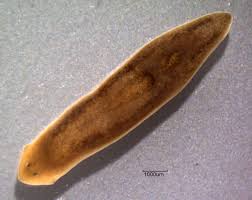
(1) They are dorsoventrally flattened like a leaf
(2) They show organ grade of organization
(3) They are acoelomate animals
(4) They are triploblastic animals.
(5) They are bilaterally symmetrical animals.
(6) Some members have segmented body.
(7) Many of the parenchyma cells give rise to muscle fibres.
(8) The digestive system is completely absent from Cestoda and Acoela.
(9) The respiratory organs are absent. In parasites respiration is anaerobic
(10) There is no circulatory system
(11) The excretory system is formed of protonephridia (flame cells)
(12) The nervous system is well developed.
(13) They are hermaphrodites, i.e., both male and female reproductive organs are present in the same animal
(14) Fertilization is internal in them.
(15) They are free-living or parasitic.
Classification of Platyhelminthes
Class 1 - Turbellaria
(1) Most of the turbellarians are free living but some of them are ecotocommensal or parasitic
(2) The body epidermis is either cellular or syncytial
(3) Segmentation is absent
(4) Digestive system is present except in a few
(5) Suckers are absent
(6) Life cycle is simple
(7) Example: Dugesia, Notoplana, Bipalium
Class (2) – Trematoda
(1) Ecto or endoparasites of vertebrates; commonly called flukes.
(2) Body mostly oval, unsegmented.
(3) Body wall without cilia, but covered by a thick, resistant, syncytial tegument.
(4) Suckers, and often hooks and spines, present for attachment to host tissues.
(5) Sense organs usually absent in adults.
(6) Digestive system well developed with terminal mouth, but no anus.
(7) Mostly hermaphrodite. Life cycle is simple or complicated.
(8) Examples: Polystomum, Fasciola, Schistosoma (blood fluke of man and other mammals).
Class (3) – Cestoda
(1) All are endoparasites. Mostly found in alimentary canal of vertebrates; commonly called tapeworms.
(2) Body long and slender, tape-like, usually divided into small segments
(3) Body wall non-ciliated, with a thick tegument.
(4) Anterior end with suckers and other attachment organs.
(5) No mouth; digestive system absent.
(6) Sense organs absent.
(7) Each proglottid contains one or two complete sets of hermaphrodite (bisexual) reproductive organs.
(8) Life-cycle usually complicated with alternation of hosts. Embryo hooked.
(9) Examples – Taenia, Echinococcus, Hymenolepis.
Phylum Nematoda (or Nemanthelminthes)
(i) The term “Nematoda” literally means “threadworms” or “roundworms” (Gr., nema = thread + eidos = form).
Salient features
(1) Many endoparasites of various animals and plants.
(2) Mostly minute or small; some large (1 mm to 25 cm); some upto several metres long.
(3) Slender, cylindrical, elongated body usually tapering towards both ends, and non-segmented.
(4) Body wall formed of a thick, tough and shiny cuticle.
(5) The false body cavity, or pseudocoel is spacious, with a fluid but no free cells
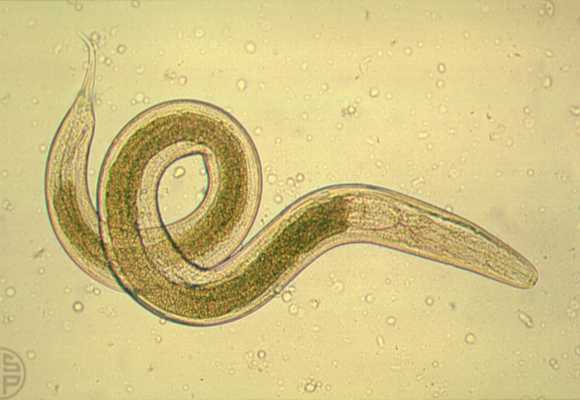 (6) Straight alimentary tract with terminal mouth and anus
(6) Straight alimentary tract with terminal mouth and anus
(7) Circulatory system and respiratory organs absent.
(8) They are usually unisexual with sexual dimorphism.
(iii) Classification of Nematoda: On basis of the presence of absence of some specialized sense organs and caudal glands, and characteristics of excretory system, nematodes are classified into two classes:
Class (1) – Phasmidia or Secernentea
(1) Mostly parasitic.
(2) Possess a pair of unicellular, pouch-like sense organs, called plasmids.
(3) Another pair of reduced, pore–like sense organs, called amphids, present near anterior end.
(4) Excretory system with paired lateral canals.
(5) Caudal glands absent.
(6) Examples – Ascaris, Enterobius, Ancylostoma, Wuchereria, etc.
Class (2) – Aphasmidia or Adenophorea
(1) Mostly small, free-living.
(2) No phasmids.
(3) Amphids spiral, cord like or disc like, seldom pore like.
(4) No lateral excretory canals.
(5) Caudal glands present.
(6) Examples – Tichinella, Capillaria etc.
Phylum Mollusca
(i) Basically bilateral and protostomial eucoelomate eumetazoans whose soft body (L., mollis or molluscum = soft)
is non-segmented and enclosed within a skin–fold (mantle) which usually secretes a calcareous shell.
Salient Features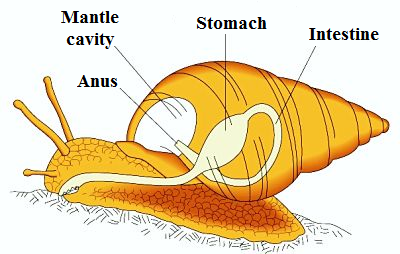
(1) Molluscs are multicellular organisms
(2) They have a bilateral symmetry, but snails are asymmetrical
(3) They are triploblastic animals.
(4) They are coelomate animals.
(5) They have organ system grade of organization.
(6) The body is soft and non-segmented.
(7) The soft body is covered by a fleshy fold of the body wall. It is called mantle.
(8) The molluscs are provided with one or two calcareous shells.
(9) Respiration is carried out by the gills or pulmonary chambers.
(10) The digestive system is well developed.
(11) The circulatory system is of an open type.
(12) The excretory organ is the kidney.
(13) The nervous system is well developed.
(14) The sensory organs are eyes, statocysts and osphradia.
(15) Sexes are separate in them, or they are hermaphrodites.
(16) The development in their case in either direct or indirect
Classification of Mollusca
Class 1 - Aplacophora or Solenogasters
-
The body is worm–like, bilaterally symmetrical and cylindrical.
-
The head, mantle, foot, shell and nephridia are absent.
-
The body is covered with spicule–bearing cuticle.
-
The digestive tract is straight with radula.
-
A mid dorsal longitudinal keel or crest is often present.
-
Example: Neomenia, Chaetoderma, etc.
Class 2 - Monoplacophora
-
The body is bilaterally symmetrical and segmented.
-
The shell is formed of a single valve.
-
The head is without eyes and tentacles.
-
The gills are external and serially arranged.
-
The nephridia are five pairs.
-
Example: Neopilina galatheae
Class 3 - Polyplacophora
-
These molluscs are bilaterally symmetrical, and dorsoventrally flattened.
-
The shell is composed of a longitudinal series of 8 plates.
-
The foot is flat and ventral.
-
The radula is well developed.
-
Example: Chiton, Cryptochiton, etc.
Class 4 - Gastropoda
-
It seems that these animals are moving on their stomach. Hence, the name is gastropoda.
-
Gastropods are marine, fresh water or terrestrial animals. A few are parasitic.
-
The body is non-segmented and asymmetrical.
-
The shell is univalve and spirally coiled.
-
The head is distinct. It bears tentacles, eyes and a mouth.
-
The foot is ventral and muscular.
-
The buccal cavity is provided with a radula.
-
The circulatory system is open.
-
The sexes are mostly separate, while some forms are hermaphrodite.
-
The development includes veliger and trochophore larvae.
-
Examples: Haliotis, Cypraea (Cowrie) Pila (apple snail)
Class 5 - Scaphopoda
-
The foot is boat–shaped.
-
The eyes, the tentacles and ctenidia are absent.
-
Marine, bilaterally symmetrical molluscs.
-
Examples: Dentalium, Siphonodentalium and Pulsellum
Class 6 - Pelecypoda
-
Pelecypoda are aquatic in habit.
-
The body is bilaterally symmetrical and laterally compressed.
-
The shell is formed of two distinctive shell plates.
-
The head is not distinct.
-
The alimentary canal shows a crystalline style.
-
The gills, excretory organs and the other structures are paired.
-
The sexes are separate or united.
-
The development is indirect having a glochidium larva.
Class 7 - Cephalopoda
-
The body is bilaterally symmetrical.

-
The foot is modified into arms and funnel.
-
The shell may be either absent or rudimentary
-
The odonotophore with a radula is present.
-
The ink–gland is present.
-
The sexes are separate.
-
The development is direct hence no metamorphosis and larval stage.
-
Example: Nautilus, Loligo Sepia, Octopus
Phylum Echinodermata
(i) The term “Echinodermata” means spiny skin (Gr., echinos = spiny + dermatos = skin).
Salient features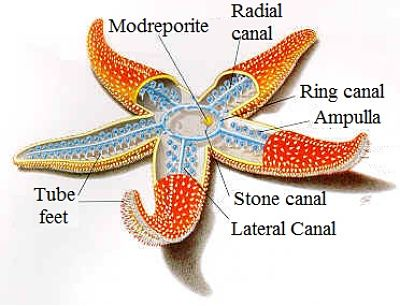
(1) Echinoderms are exclusively marine beings.
(2) They are triplobalstic and coelomate animals.
(3) They have radially symmetrical body.
(4) They have organ system grade of organization.
(5) They have well developed
(6) They have a water–vascular system with tube–feet for locomotion, feeding and respiration.
(7) Circulatory system is of the open–type.
(8) The sensory organs are poorly developed.
(9) The excretory organs are absent.
(10) They have pedicellariae.
(11) Development is indirect.
(12) The larval forms are bilaterally symmetrical.
Classification of Echinodermata
Subphylum I - Eleutherozoa : Free-living echinoderms
Class 1 - Asteroidea
-
Starfishes or sea stars.
-
Arms 5 or more and not sharply marked off from the central disc.
-
Tube feet in orally placed ambulacral grooves; with suckers.
-
Anus and madreporite aboral.
-
Pedicellariae present.
-
Free-living, slow-creeping, predaceous and scavengerous.
Class 2 - Ophiuroidea
-
Brittle-stars and allies.
-
Body star-like with arms sharply marked off from the central disc.
-
Pedicellariae absent.
-
Stomach sac-like; no anus.
-
Ambulacral grooves absent or covered by ossicles; tube feet without suckers.
-
Madreporite oral.
Class 3 - Echinoidea
-
Body not divided into arms; globular (sea urchins), or flattened disc-like (sea-cakes).
-
Mouth at lower pole, covered by 5 strong and sharp teeth, forming a biting and chewing apparatus called “Aristotle's Lantern”.
-
Tube-feet slender with suckers.
-
Skin ossicles fused to form a rigid globular, disc like, or heart-shaped shell or test with movable spines.
-
3–jawed pedicellariae present in skin.
-
Gut long, slender and coiled.
-
Larval forms pluteus and Echinopluteus.
-
Examples – Sea urchins and sand dollars etc.
Class 4 - Holothuroidea
-
Body massive, long and cylindrical like a cucumber
-
Mouth at anterior and anus at posterior ends.
-
Mouth surrounded by many hollow retractile tentacles.
-
Tube feet usually present; sucker-like.
-
Skin leathery, but relatively soft, without spines or pedicellariae; may have an endoskeleton of minute calcareous ossicles.
-
Respiration and excretion by two long and highly branched tubes (= respiratory tree) extending into coelom from cloaca.
-
Larval form Auricularia.
-
Examples – Holothuria, Cucumaria etc.
-
Subphylum II - Pelmatozoa: Stalked, sedentary echinoderms.
Class 5 - Crinoidea
-
Body flattened and pentamerous.
-
Disc enclosed in a hard, cup–shaped calyx formed of calcareous plates.
-
Mouth in middle and anus excentral upon a cone, both upon oral surface.
-
Tube feet sucker–like; restricted to central disc; can help in food–collection.
-
Some forms (sea–lilies) permanently sessile and attached to sea–bottom by a long stalk; others (feather stars) free-swimming.
-
Spines and pedicellariae absent in skin.
-
Examples – Sea lilies and Feather stars (Antedon)
Phylum Chordata
Superclass Pisces
Class 1 - Chondrichthyes (Cartilaginous Fishes)
General characters:-
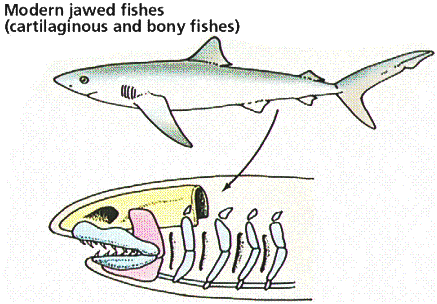 (1) Mostly marine and predaceous.
(1) Mostly marine and predaceous.
(2) Body fusiform or spindle shaped.
(3) Fins both median and paired, all supported by fin rays.
(4) Skin tough containing minute placoid scales and mucous glands.
(5) Endoskeleton entirely cartilaginous, without true bones
(6) Notochord persistent.
(7) Respiration by 5 to 7 pairs of gills.
(8) Heart 2–chambered (1 auricle and 1 ventricle).
(9) Kidneys opisthonephric. Excretion is ureotelic.
(10) Brain with large olfactory lobes and cerebellum. Cranial nerves 10 pairs.
Class 2 - Osteichthyes (Bony fishes)
General Characters:-
(1) Inhabit all sorts of water-fresh, brackish or salt; warm or cold.
(2) Body spindle-shaped and streamlined.
(3) Fins both median and paired, supported by fin rays of cartilage or bone.
(4) Skin with many mucous glands, usually with embedded dermal scales of 3 types; ganoid, cycloid or ctenoid.
(5) Endoskeleton chiefly of bone.
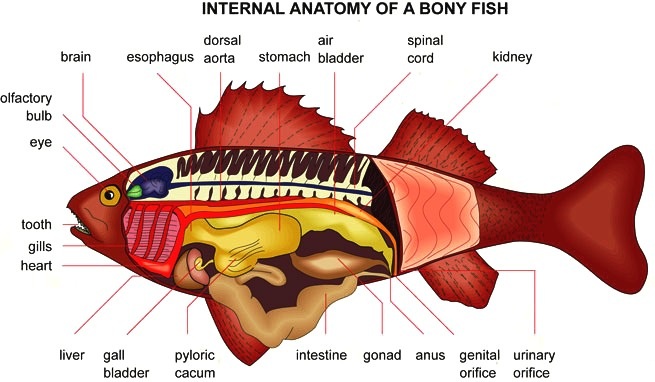
(6) Respiration by 4 pairs of gills on body gill arches
(7) Ventral heart 2-chambered (1 auricle + 1 ventricle).
(8) Adult kidneys mesonephric. Excretion is ureotelic.
(9) Brain with very small olfactory lobes, small cerebrum and well developed optic lobes and cerebellum.
(10) Well developed lateral line system.
Class Amphibia
General characters:-
(1) Aquatic or semi aquatic (freshwater), air and water breathing, carnivorous, cold–blooded, oviparous, tetrapod vertebrates.
(2) Head distinct, trunk elongated. Neck and tail may be present or absent.
(3) Pigment cells (chromatophores) present.
(4) Exoskeleton absent.
(5) Endoskeleton mostly bony. Notochord does not persist. Skull with 2 occipital condyles.
(6) Respiration by lungs, skin and mouth lining.
(7) Heart 3–chambered (2 auricles + 1 ventricle).
(8) Kidneys mesonephric. Excretion is ureotelic.
(9) Brain poorly developed. Cranial nerves 10 pairs.
(10) Nostrils connected to buccal cavity.
Class Reptilia
General characters:-
(1) Predominantly terrestrial, creeping or burrowing.
(2) Body bilaterally symmetrical and divisible into 4 regions-head, neck, trunk and tail.
(3) Limbs 2 pairs, pentadactyle.
(4) Exoskeleton of horny epidermal scales, shields, plates and scutes.
(5) Skin dry, cornified and devoid of glands.
(6) Alimentary canal terminates into a cloacal aperture.
(7) Endoskeleton bony. Skull is with one occipital condyle (monocondylar).
(8) Heart usually 3–chambered, 4–chambered in crocodiles.
(9) Respiration by lungs throughout life.
(10) Kidney metanephric. Excretion is uricotelic.
Class Aves
General characters:-
(1) Feather-clad, air-breathing, warm-blooded, oviparous, bipedal flying vertebrates.
(2) Limbs are two pairs.
(3) Exoskeleton is epidermal and horny.
(4) Skin is dry and devoid of glands except the oil or preen gland at the root of tail.
(5) Pectoral muscles of flight are well developed.
(6) Skull smooth and monocondylic, bearing a single occipital condyle. Cranium large and dome-like. Sutures indistinct.
(7) Vertebral column short. Centra of vertebrae heterocoelous (saddle-shaped).

(8) Sternum large, usually with a vertical, mid ventral keel for attachment of large flight muscles.
(9) Ribs double-headed (bicephalous) and bear posteriorly directed uncinate processes.
(10) Both clavicles and single inter clavicle fused to form a V–shaped bone, called furcula wishbone.
(11) Heart completely 4–chambered. There are neither sinus venosus or truncus arteriosus. Only right aortic (systemic) arch persists adult. Renal portal system vestigial. Blood corpuscles nucleated.
(12) Birds are the first vertebrates to have was blood. Body temperature is regular (homoiothermous).
(13) Respiration by compact, spongy, distensible lungs continuous with thin air-sacs.
(14) Larynx without vocal cords. A sound box or syrinx, producing voice, lies at or near the junction of trachea and bronchi.
(15) Kidneys metanephric and 3–lobed.
Class Mammalia
General characters:-
(1) Hair-clad, mostly terrestrial, air-breathing, warm blooded, viviparous, tetrapod vertebrates.
(2) Limbs 2 pairs, pentadactyle, each with 5 or fewer digits. Hind limbs absent in cetaceans and sirenians.
(3) Exoskeleton includes lifeless, horny, epidermal hairs, spines, scales, claws, nails, hoofs, horns, bony dermal plates, etc.
(4) Skin richly glandular containing sweat, sebaceous (oil) and sometimes scent glands in both the sexes. Females also have mammary glands with teats producing milk for suckling the young.
(5) Endoskeleton thoroughly ossified. Skull dicondylic having 2 occipital condyles. Cranium large. A single zygonmatic arch present. Pterygoids msall, scale-like. Otic bones fused into periotic which forms tympanic bulla with tympanic. Each half of lower jaw made of a single bone, the dentary, articulating with squamosal of skull Vertebrae with terminal epiphyses and flat centra (acoelous). Cervical vertebrae usually 7. Ribs bicephalous. Coracoid vestigial.
(6) Teeth are of several types (heterodont), borne is sockets (thecodont) and represented by two sets (diphyodont).
(7) Respiration always by lungs (pulmonary). Glottis protected by a fleshy and cartilaginous epiglottis. Larynx contains vocal cords.
(8) Heart 4-chambered with double circulation.

(9) Kidneys metanephric.
(10) Brain highly evolved. Both cerebrum and cerebellum large and convoluted. Optic lobes small and 4 in number called corpora quadrigemina. Corpus callosum present connecting both cerebral hemispheres. Cranial nerves 12 pairs.
(11) Senses well developed. Eyes protected by lids, the upper of which is movable. External ear opening protected by a large fleshy and cartilaginous flap called pinna. Middle ear cavity with 3 ear ossicles–malleus, incus and stapes. Cochlea of internal ear spirally coiled.
(12) Sexes separate.
(13) Fertilization internal preceded by copulation.
(14) Except egg-lying monotremes, mammals are viviparous, giving birth to living young ones.
(15) Development uterine.
Classification of Mammal
(a) Subclass I prototheria : (Gr., protos, first + therios, beast). Primitive, reptile-like, oviparous or egg-lying mammals.
Order 1. Monotremata : (Gr., monos, single + trema, opening), Cloacal opening present Confined to Australian region.
Examples : Monotremes. Platypus or duckbill (ornith orhynchus) spiny anteater (Tachyglossus = Echidna)
(b) Sub class II. Theria : (Gr., ther, Theria are subdivided into 2 living infraclasses)
Infraclass 1. Metatheria : (Gr., meta, between or after).
Pouched and viviparous mammals without or with a rudimentary yolk sac placenta. Confined mostly to Australian region.
Order 2. Marsupialia : (Gr., marsypion, pouch).
Born in a very immature state, and complete their development attached to teats or nipples in the abdominal pouch or marsupium. Usually 3 premolars and 4 molars in each jaw on either side. Vagina double
Examples : Marsupials. Opossum (Didelphis). Kangaroo (macropus), koala (phascolarctos). Kangaroo in the native of Australia
Infraclass 2. Eutheria : (Gr., eu, true + therios + beast)
Higher viviparous placental mammals without marsupium. Young born in a relatively advanced stage. Dentition never exceeds Eutherians constitute the vast majority of living mammals arranged in 16 orders.
 Order 3. Insectivora : (L., insectum, insect + vorare, to eat)
Order 3. Insectivora : (L., insectum, insect + vorare, to eat)
Small mammals with long pointed snout. Feet plantigrade, usually 5–toed, with claws. Molars with pointed, peg-like cusps for insect feeding.
Examples : Mole (Talpa), common shrew (Sorex), Solenodon (Solenodon), hedgehogs (Erinaceus, Paraechinus)
Order 4. Chiroptera : (Gr., Cheiros, hand + pteron, wing)
Flying mammals or bats in which forelimbs are modified into wings. Hind legs short and included in wing membrane
Order 5. Dermoptera : (Gr., derm, skin + pteron, wing). Nocturnal in trees. A gliding mammal called flying lemur, resembling a flying squirrel
Examples : One living genus Cynocephalos (= Galaeoithecus) with 2 species from South eastern Asia.
Order 6. Edentata : (L., edentatus, toothless) Teeth absent or reduced to molars. Without enamel
Examples : Giant antcater (Mryrmecopha) armadillo (Dasypus),
Order 7. Pholidota : (Gr., pholis, a scale) Body covered with large overlapping scales with sparse hair in between. No teeth. Long and protrusible, used to capture insects.
Examples : Single genus of scaly anteaters pangolins (Manis)
Order 8. Tubulidentata : (L., tubulus tube like + dens, tooth)
Examples : Single genus of pig-like aardvark or Cape anteater (Orycteropus) of South Africa
Order 9. Primates : (L., primus, of the first rank)
Generalized or primitive mammals except for the great development of brain. Mostly arboreal. Anthropoidea. The suborder Anthropoidea is further subdivided into two divisions or infraorders, Platyrrhina and Catarrhina.
Order 10. Rodentia : (L., rodo, gnaw)
Largest order including usually small gnawing mammals. Each jaw with one pair of long, rootless, chisel-like incisors growing throughout life. No canines.
Examples : Rat (Rattus), Mouse (Mus) squirrel (Funambulus)
Order 11. Lagomorpha : (Gr., logos, hare + morphe, form)
With a second pair of small upper incisors behind first pair of large chisel like incisors. No canines.
Examples : Rabbit (Oryctolagus), hare (Lepus), Pika (Ochotona)
Order 12. Cetacea : (Gr. ketos or L., cetus, a whale)
Large marine fish-like mammals well adapted for aquatic life pectoral limbs modified into broad paddle-like flippers. Tail divided in two broad horizontal fleshy flukes with a notch, used in propulsion. No claws, no hind limbs and no external ears. The living Cetacea are divided into two suborders Odontoceti (toothed whales) and Mysticeti or Mystacoceti (whalebone whales).
Order 13. Sirenia: (Gr., siren, sea nymph). Large, clumsy herbivorous, aquatic mammals with paddle-like forelimbs, no hindlimbs and a flattened tail with horizontal lateral fleshy flukes with or without a notch. No external ears.
Muzzle blunt. Hairs few. Stomach complex. Inhabit estuaries and coastal sea.
Examples: Manatee (Trichechus), dugong (Dugong = Halicore), recently extinct Steller's sea-cow (Rhytina)
Order 14. Carnivore: (L., caro, tlesh + vorare, to eat) Small to large predatory, flesh-eating mammals.
Examples: Dog (Canis familiaris), Wolf (C. lupus), Jackal (C. aureus), Walrus (Odobenus), common seal (Phoca)
Order 15. Hyracoidean : (Gr., hyrax, shrew + eidos, form)
Small, guinea-pig like mammals distantly related to elephants. No canines. Cheek teeth lophodont.
Example: Conies (Hyrax = Procavia) from S. Africa, Syria and Arabia.
Order 16. Proboscidea : (Gr., pro, in front + boskein, to eat)
Largest living land animals having large heads, massive ears, thick practically hairless skins (pachyderm), bulky straight legs and 3 to 5 toes with small, nail like hoofs. Conspicuous feature is the nose and upper lip modified as an elongated flexible proboscis or trunk. 2 upper incisors elongated as ivory tusks. Cheek teeth lophodont.
Examples: Indian or Asiatic elephant (Elephas maximus), African elephant (Loxodonta africana)
Order 17. Perissodactyla : (Gr., perissos, odd + dactylos, toes)
The odd-toed hoofed mammals or ungulates have an odd number of toes (1 or 3) incisors present in both jaws.
Examples: Horse (Equus cabalus), wild ass (Equus asinus), Zebra (Equus zebra)
Order 18. Artiodactyla : (Gr., artios, even + dactylos digit)
The even-toed hoofed mammals having an even number of toes (2 or 4)
Incisors and canines in upper jaw usually lacking. Stomach 4 – chambered. Many with antlers or horns.
Examples : Pig (Sus), common hippopotamus (Hippopotamus amphibius), camel (Camelus), deer (Cervus), musk deer (Moschus), sheep (Ovis).
View courses by askIITians


Design classes One-on-One in your own way with Top IITians/Medical Professionals
Click Here Know More

Complete Self Study Package designed by Industry Leading Experts
Click Here Know More

Live 1-1 coding classes to unleash the Creator in your Child
Click Here Know More

a Complete All-in-One Study package Fully Loaded inside a Tablet!
Click Here Know MoreAsk a Doubt
Get your questions answered by the expert for free